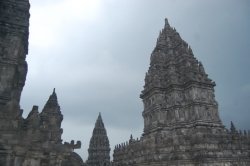
Prambanan Temple Compounds got inscribed under two criteria: as a masterpiece of human creative genius, and as an outstanding example of an architectural ensemble that represents a significant stage in human history (i.e., spread of Hinduism in the East). It happens to be the biggest and most extensive Hindu religious site in the predominantly Islamic country.
Prambanan, on one hand, may look quite similar to Angkor Wat. True enough, they are both intended as Hindu temples. From afar, these two may even look like asparagus tips :p In closer inspection, however, the temples in Prambanan are a totally different architectural masterpiece that is unique in its own way. In fact, Prambanan was built over 300 years earlier (9th century vs. 12th century). On the other hand, Prambanan still faces yet another challenge: it is often overshadowed nowadays by the more famous Borobudur given their close proximity to each other. But, in ancient times, the former might have looked far more impressive in terms of lay-out, scale of construction, and even its setting. After all, the construction of Prambanan can largely be seen as a response of the Hindu Sanjaya Dynasty to the Buddhist Sailendra Dynasty's Borobudur.
Often really crowded throughout the day, I visited Prambanan late in the afternoon instead so as to have better appreciation of the place when there would be lesser tourists getting in the way of my lens (it turned out later on to be an uncalculated risk as it rained some few minutes after!). One thing that I noticed immediately upon entering the gate is its vast, well-manicured yard. Not long from there, and I started seeing the magnitude of the damages this site had to endure: endless -- and now meaningless -- piles of rubble scattered everywhere.
The Prambanan archeaological site (or what remains of it) is pretty small and easily explorable. It has to be understood that temples currently standing in the compound hardly make up 15% of what used to be there. Originally, more than 240 temples comprise the compound, yet only a handful remains today. Throughout many centuries, earthquakes (the last strong one being the May 2006 shake) and several bouts of volcanic eruptions of Mt. Merapi further added damages to the already abandoned and neglected royal religious site since the early 10th century. So, yes, it was relatively short lived as an active place of worship.
Its central main towers are almost total reconstructions via anastylosis, and Indonesia is proud that it was all their efforts (together with the Brits!). Nevertheless, strict measures are still being observed such as prohibiting public access to the temples' interiors. The management body no longer plans to reconstruct all of the temples - the tons of rubble are there to act as a reminder of the site's painful history in confronting the destructive forces of nature. Moreoever, some stones are already missing as locals used them in building their houses nearby, rendring massive rehabilitation a definite impossibility.
It being a Trimurti site, Prambanan is dedicated to the highest three Hindu gods Brahma, Vishnu, and Shiva. The commanding 47-metre high Shiva temple (or Loro Jonggrang), the largest in the area, lies at the center. Here, a local myth is also highly intertwined with Prambanan: Loro Jonggrang is a legendary Javanese princess, and it is believed that she is depicted in a statue inside the Shiva temple; hence, the Shiva temple is often referred to by locals as Loro Jonggrang temple as well. This legend is worth knowing when visiting this temple. The carvings and reliefs in the temples are quite different from those that I have seen in Angkor, though both depict Hindu characters,icons, and stories. I can say that the images and artworks there are more "pure" in the Hindu sense of the word; in contrast, Angkorian art is made in the image of the Khmers.
Prambanan never failed to enchant me. Despite only having a little more than an hour for this site (thanks to the rain!), it left a lasting impression on me: the temple compound is really simple -- and it may not even boast much given the state it is in right now -- but it never fails to assert its right as a 'classic' monument the world will forever be proud of.
On a separate day, I also went to the nearby ruins of the 8th-century Ratu Boko Palace. Actually, it happens to be on the tetative list of Indonesia for a possible inclussion to the WHS list, too! Ratu Boko (I'll be writing a separate note for this site as it deserves one of its own!) is nestled in the Boko Hills, some 3km from Prambanan temple compounds. Given its altitude of 196 metres, the site offers a commanding view of the Prambanan plains and townscape, with Mt. Merapi as the background. In the evening, the beautifully glittering Prambanan temple dominates the skyline, subtly suggesting that it is there to stay and that it will never be forgotten again.
Oh, lastly, one thing that can really surprise a bit is how Indonesians usually ask to take photos of/with foreigners, and I was not an exception even in Borobudur. As a traveler, it's part of the local charm of the place, I would say.
Comments
No comments yet.
